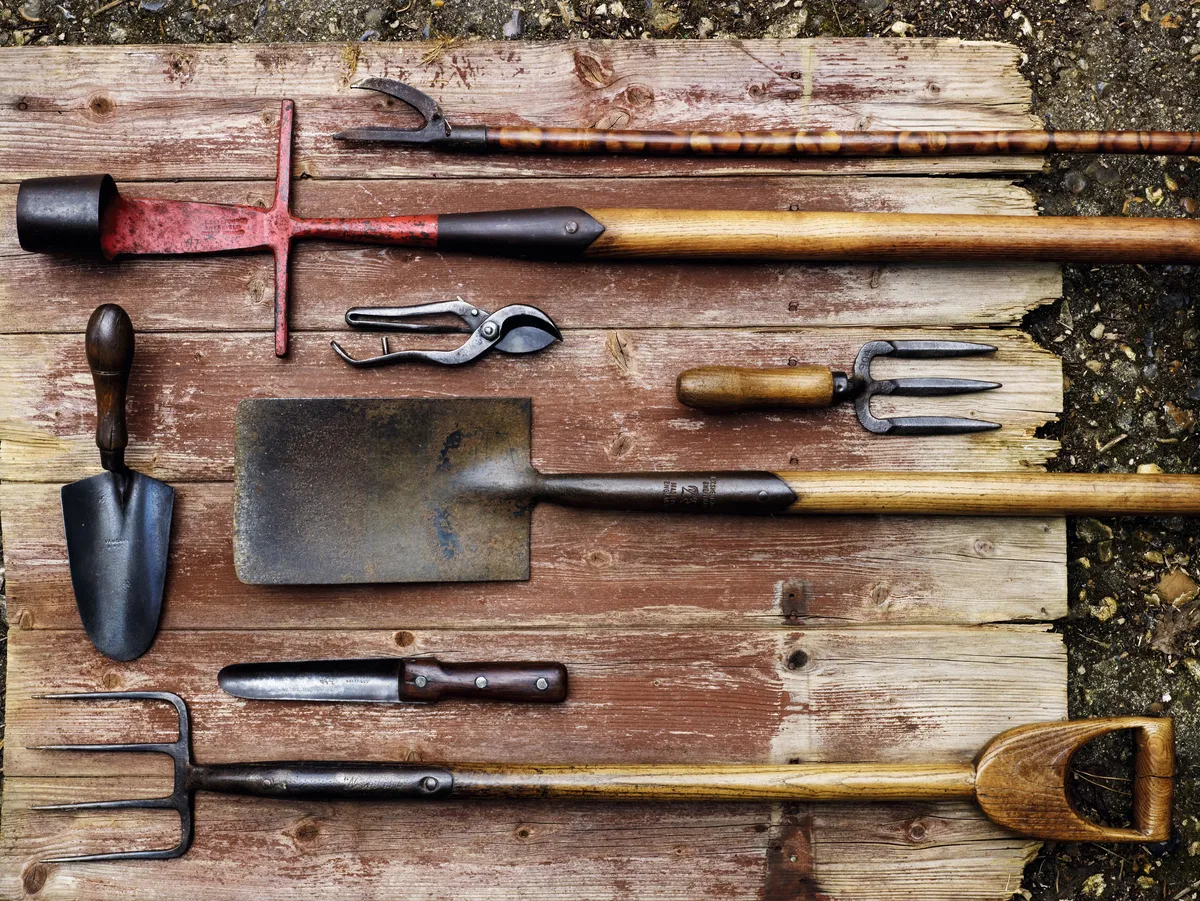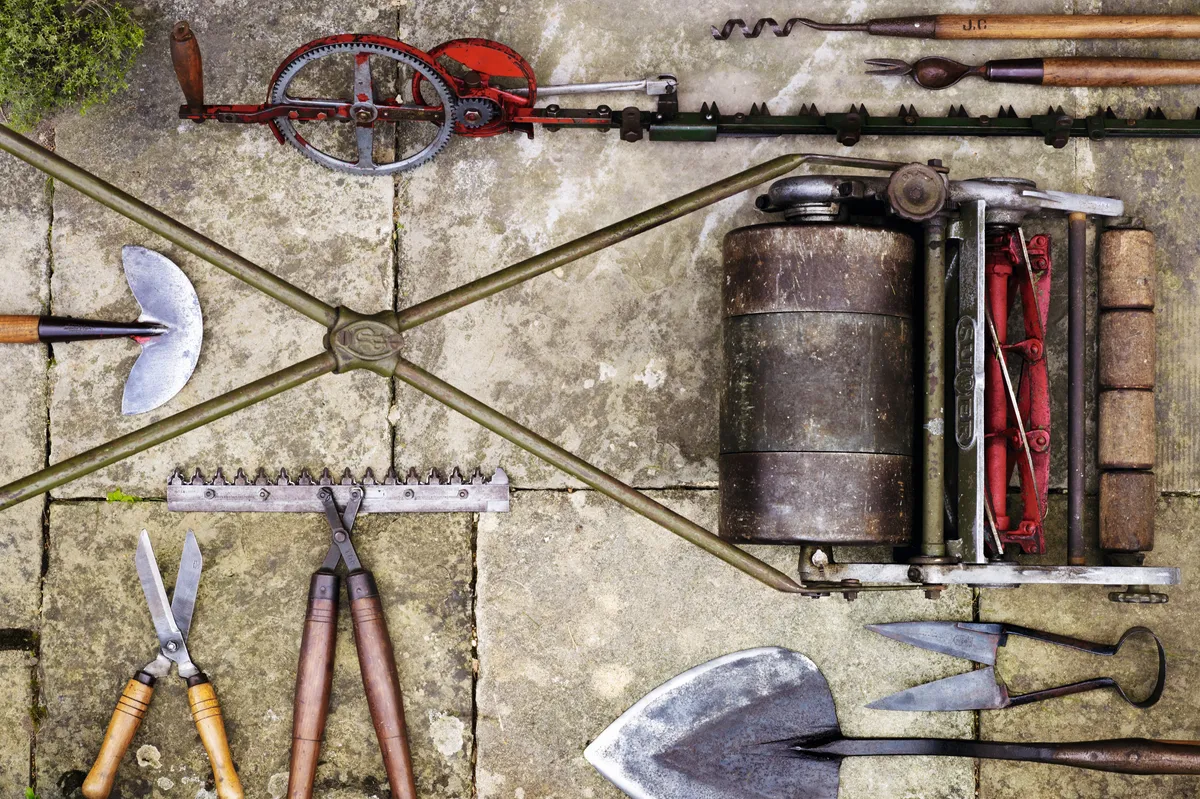Tools for the flower border
(from the top)

Antique tools often highlight the ingenuity of previous generations. This early 20th-century tool, known as the Little Gripper flower picker, both cuts and grips flowers, allowing you to pick flowers in the back of the border with ease.
The classic design of some tools has never been bettered. This early 20th-century, Barr’s pattern bulb planter, is sturdy and strong and makes the planting of bulbs so much less of a challenge.
A tool that looks very familiar to us today is this garden trowel made by Vaughan in the 1930s, which is both practical and sturdy.
Garden secateurs come in a multitude of different shapes and sizes. These distinctive Aubert’s pattern secateurs from the latter part of the 19th century sit in the hand beautifully.
A good, sturdy, hand fork is an essential piece of kit for weeding. This example has been cast rather than pressed to make it stronger, while its traditional ash handle has been polished through many years of use, which has made the tool extremely good to hold.
Another useful tool is the border spade. This smaller-sized spade is perfect for preparing a hole in a closely planted border.
Part of the attraction of old tools is their diversity. The small and rare fern trowel from 1910, was in its day much prized by plant collectors and today is equally valued by collectors of vintage tools.
One of the most desirable of all classic garden tools, however, is the small border fork. Originally known as a ladies fork, it is now much in demand by male and female gardeners alike.
Tools for the produce garden
(from the top)

Dibbers, the pointed tools used for creating holes for seed or bulbs, come in all shapes and sizes. They range from the long-handled, blacksmith-made field dibber, which was once commonly used on Norfolk farms, to the more domestic, T-handle dibber with its steel tip. Both tools make the job of planting leeks a joy.
Although it shares a name with the pair of tools above, the dandee dibber is actually a weeding tool. Dating back to the 1930s. It was manufactured by the British company Ardinco.
One of the great pleasures of planting vegetables is watching them grow in a perfect, straight line. The best way to achieve such perfection is to use a garden line or spinner. This particular example was made by a blacksmith in 1880 and is notable for its triangular spike.
To ensure a perfect vegetable plot you should also sow the correct amount of seed in each row. Over the years several tools have come along to make this job simpler, but this brass, Goodstart seed spacer with adjustable holes for different-sized seed has to be one of the neater solutions.
It’s also important that seed is planted at the correct depth and the Prestige measuring trowel, with its curved, scaled blade, is perfect for the task. It takes its inspiration from the Victorian fern trowel (see above), and is equally desirable. It’s often debatable at what point a tool can really be called a classic, but this simple tool from the 1960s, with its beautifully shaped handle, is such joy to hold and use it more than justifies that description.
Another beautifully simple tool is this French harvesting hook with a curved serrated edge and polished bone handle. After all the hard work that goes into growing your vegetables you really need to choose the perfect tool to harvest all your bounty.
When it comes to harvesting, some vegetables demand a specific tool, and asparagus is one such example. This long-handled, English asparagus knife with a serrated edge is just the tool for the job.
Weeding can be tricky in closely planted borders, but over the years several tools have been developed to make life easier. This weeder, with its two-pronged head, is ideal for pulling up pesky roots. Like the dandee dibber (above) it was made in the 1930s by Ardinco.
French tools are often ornate in design, such as this intricately manufactured, funnelled apple-picking crown from the 1950s, which is a perfect example of how to harvest in style.
Keeping rows of vegetables weed free has long been a challenge for gardeners and tool designers alike. The hand-held onion hoe is perfect for this task.
Small, hand-held spades were frequently used in large market gardens in Lincolnshire, where they were referred to as cabbage planting spades. Somehow the alternative name of strawberry planting spade, makes this lovely, little T-handled spade all the more appealing.
Another stylish tool from France is this comb-like berry harvester. Perfect for pulling currants and gooseberries from the bush.
Tools for lawns and hedges
(from top and starting from left)

The early part of the 20th century saw the arrival of mechanisation in garden tools, such as the All Britisher Little Wonder hedge trimmer. It may look primitive compared with today’s power tools, but when it was introduced, this rotary trimmer, which needed two men to operate it, was seen as a real labour saver.
The Edwardians were also keen on labour-saving devices and passionate about keeping their lawns free of weeds. This clever gentlemen’s corkscrew weeder from 1910, made by Cornelius Whitehouse, was designed for laying waste to annoying dandelions.
The daisy grubber is another solution for weed-free lawns, although this tool has only the humble daisy in its sights.
To add a crisp, sharp edge to your immaculate weed-free lawn, the half moon lawn edging iron, from the 1950s, has long been a must.
Another must, if you wanted immaculate stripes to go with that crisp edge, was the cylinder lawnmower. The first lawnmower was invented by Edwin Budding in 1827, but this one, manufactured by JP Super, dates from the 1920s. It was an instant success despite its relatively high price tag.
Just as important as the perfect lawn is the well-kept hedge. Traditional hedge shears, such as these from the 1960s, have earned a place in many a well-stocked tool shed and often come up for sale. Many are still perfectly suitable for use today.
Some tools, however, are probably only for collectors and not for the more practical gardener. This pair of Trenton hedging shears, was made in the USA in 1919, and has very delicate teeth.
Many gardeners over the years have favoured sheep shears for trimming hedges. They are perfect for creating topiary.
The extended handle and sharp pointed edges of this 1930s turf-lifting iron make this still the perfect tool for lifting small amounts of turf.
Starting a collection
If you like the idea of adding classic and vintage tools to your collection – and you have the time and inclination to spend your weekends visiting flea markets, car boot sales and auctions – you can still find many unrestored garden tools in need of a home. Make sure you check first they’re in good condition. Woodworm can be the death of even the most beautiful of tools so look out for those tell-tale holes and be prepared to replace handles if need be. Alternatively, take a look at the suppliers below, who have beautiful, well-restored tools for sale:
To find more about vintage garden tools visit the collection at Waterperry Gardens in Oxfordshire.
Photography Andrew Montgomery